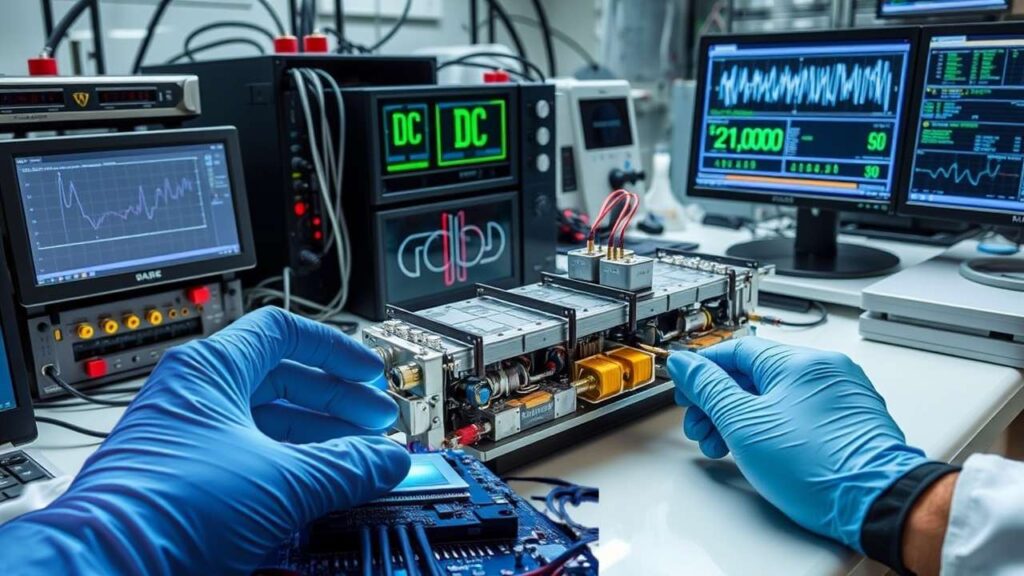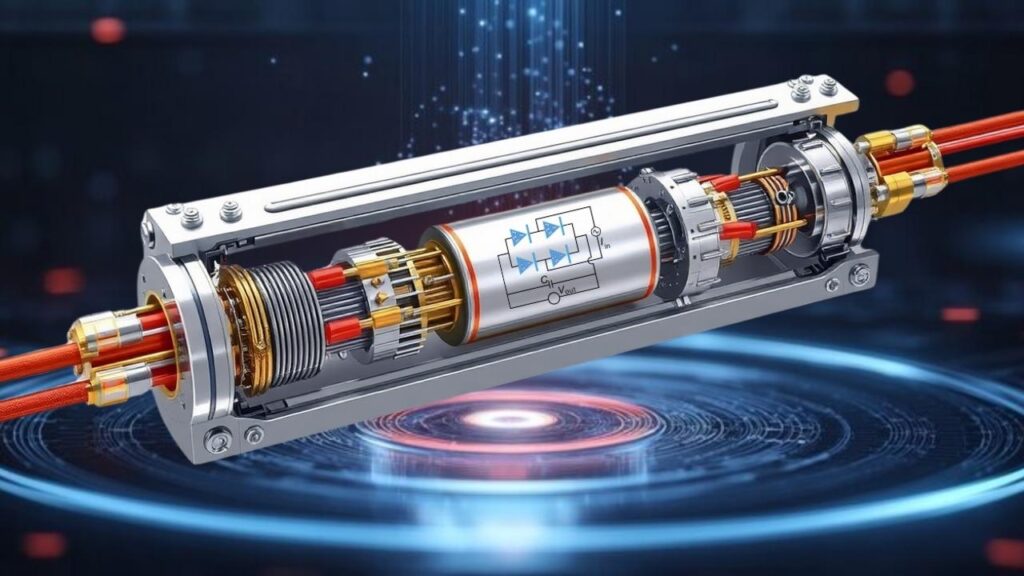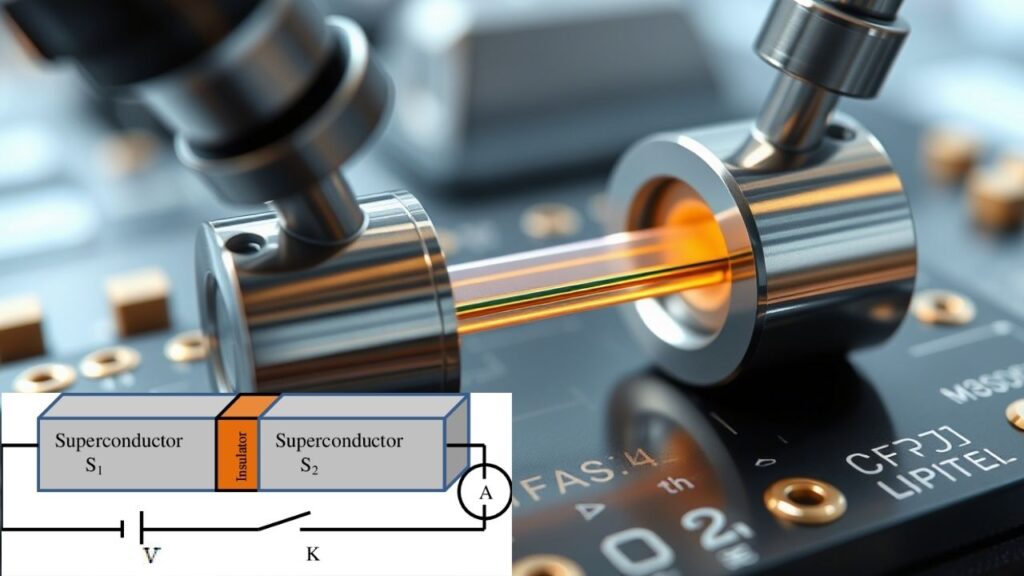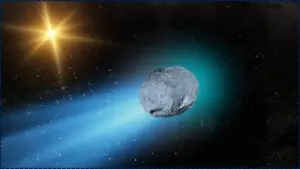Superconducting Diode Bridge Efficiently Converts AC to DC for Quantum Circuits: A new superconducting diode bridge designed by researchers from MIT, UC Riverside, and SEEQC Inc. promises a breakthrough in power conversion for quantum circuits. This innovative device operates efficiently in cryogenic environments and may solve long-standing challenges in delivering direct current (DC) power within ultra-cold quantum systems.

Quantum computing requires precision and extreme environmental control. One of the biggest technical hurdles is the conversion of alternating current (AC) to direct current (DC) at near-zero temperatures. Traditional converters create heat and signal interference. The new superconducting diode bridge offers a compelling solution with rectification efficiencies up to 42% at temperatures as low as 1.7 Kelvin.
Table of Contents
Superconducting Diode Bridge Efficiently Converts AC to DC for Quantum Circuits
| Feature | Description |
|---|---|
| Technology | Superconducting Diode Bridge |
| Main Use | Converts AC to DC in cryogenic systems |
| Efficiency | Up to 42% ± 5% |
| Operating Frequency | Up to 40 kHz |
| Operating Temperature | Approximately 1.7 Kelvin |
| Lead Institutions | MIT, UC Riverside, SEEQC Inc. |
| Quantum Application | On-chip cryogenic power delivery |
| Fabrication | Compatible with standard nanofabrication |
| Official Source | Phys.org Coverage |
| Published Research | arXiv:2406.12012 |
The superconducting diode bridge is more than just a technical novelty—it represents a pivotal advancement in quantum computing infrastructure. By solving the problem of power conversion at near-zero temperatures, this innovation paves the way for efficient, stable, and scalable quantum computers.
Its compatibility with current fabrication methods, cryogenic readiness, and integration flexibility make it a practical solution, not just a lab experiment. As quantum systems grow more complex, expect to see technologies like this bridge form the silent backbone powering the future of computation.
What Is a Superconducting Diode Bridge?
A diode bridge is a circuit that turns AC into DC by allowing current to pass in only one direction. In everyday electronics, these bridges are used in chargers, radios, and computers. But standard diodes can’t work in quantum computers due to the heat and noise they generate.

A superconducting diode bridge, on the other hand, uses materials that lose all electrical resistance when cooled to near absolute zero. That means it can perform the same task—converting AC to DC—without any energy loss or heat production. It’s also compact and ideal for integration directly inside quantum systems.
A Brief History: Why This Matters Now
Superconductivity has been studied since the early 1900s, but only in the past two decades has its role in quantum computing become critical. While superconducting qubits have shown great promise, the surrounding hardware—like power delivery systems—has lagged behind.
Until now, converting power inside cryogenic systems was inefficient and bulky. The new diode bridge marks a paradigm shift, offering a small, highly efficient way to power quantum systems internally without the need for complex warm-to-cold conversions.
How It Works: The Science in Simple Terms
Let’s break down the working of this diode bridge into key parts:
Full-Wave Rectification
The device uses four superconducting diodes in a full-wave configuration, ensuring that both halves of the AC waveform are used. This doubles the efficiency compared to half-wave designs.
Nonreciprocal Superconducting Diodes
These diodes allow current to pass only in one direction, a property known as nonreciprocity. This is achieved using ultrathin superconducting films paired with ferromagnetic insulators.
Cryogenic Operation
The entire system is designed to work at about 1.7 Kelvin, which is essential for compatibility with superconducting quantum circuits like Josephson junctions and SQUIDs.
Comparison: Superconducting vs Traditional Diode Bridges
| Feature | Traditional Diode Bridge | Superconducting Diode Bridge |
|---|---|---|
| Efficiency | ~70% (at room temp) | Up to 42% at cryogenic temps |
| Heat Generation | High | None (zero resistance) |
| Operating Temp | Room temperature | ~1.7 K (cryogenic) |
| Size | Larger, with heatsinks | Compact, chip-scale |
| Quantum Compatibility | No | Yes |
Real-World Applications and Use Cases
- Quantum Computers: Powering superconducting qubits and readout amplifiers without heat loss.
- Cryogenic Control Systems: Running on-chip control logic with minimal energy use.
- Advanced Research Labs: Precision experiments requiring stable, ultra-cold environments.
- Space Electronics: Potential use in deep-space cryogenic probes or sensors.
Challenges and Limitations
Despite its promise, the technology is still in early development. Some challenges include:
- Manufacturing Scalability: Although compatible with standard techniques, mass production is untested.
- Integration Complexity: Requires careful design to avoid magnetic interference with quantum elements.
- Efficiency Limits: While 42% is impressive at cryogenic levels, it’s lower than silicon-based rectifiers at room temperature.
Expert Commentary
Dr. Julian Chien, a quantum hardware expert from the University of Chicago, said:
“This is exactly the kind of innovation we need to make scalable quantum computing a reality. The ability to handle power conversion within the cryogenic chamber is a significant step toward autonomous, large-scale quantum processors.”
Related Technologies
- Josephson Junctions: Key elements of superconducting qubits.

- Cryostats: The cold chambers where quantum circuits operate.
- Flux Qubits: Another superconducting circuit benefiting from cryogenic components.
- Reversible Computing: Could be enhanced by low-energy superconducting logic.
Step-by-Step Guide: How the Bridge Fits Into a Quantum Computer
Step 1: AC Signal Input
An AC signal is introduced into the cryogenic system from an external power source.
Step 2: Superconducting Diode Bridge Activation
The bridge immediately rectifies the signal, converting it into DC without heat.
Step 3: On-Chip DC Power Delivery
The DC current powers cryogenic amplifiers, bias circuits, and even qubit control modules.
Step 4: Stable Quantum Operation
System stability improves thanks to reduced noise and no warm-to-cold transition losses.
Reticular Materials Gain Traction in Carbon Capture Technologies
European Startups Achieve Breakthroughs in Recycling EV Battery Materials
Robotic Automation Enhances Scalability of 2D Materials for Electronic Devices
FAQs About Superconducting Diode Bridge Efficiently Converts AC to DC for Quantum Circuits
What’s the primary advantage of a superconducting diode bridge?
It performs AC to DC conversion without any resistance or heat loss, making it ideal for quantum systems that operate at cryogenic temperatures.
Can this be used in everyday electronics?
No, this technology is designed for specialized cryogenic environments like quantum computers or lab-based cryostats.
How efficient is it compared to traditional rectifiers?
While traditional silicon rectifiers can reach 70-90% efficiency at room temperature, they don’t function well at cryogenic temperatures. This bridge achieves up to 42% efficiency in extreme cold, which is groundbreaking for its environment.
Who developed this?
The bridge was developed by teams from MIT, University of California, Riverside, and SEEQC Inc.



















